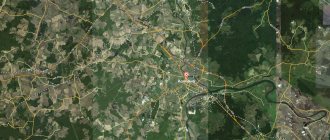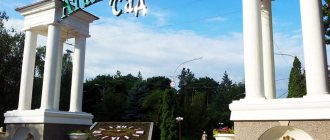Komsomolsk-on-Amur is the second largest city in the Khabarovsk Territory in terms of population and area, and has gained fame as the largest industrial center of the entire Far Eastern Federal District of the Russian Federation. It couldn't have been any other way. After all, the emergence of the policy was a consequence of the implementation of grandiose plans for the industrialization of one of the then outskirts of Tsarist Russia, which had sunk into oblivion. In just two years, volunteers - soldiers of the labor army of the country of the Soviets and thousands of political prisoners - managed to perform a real miracle. Thanks to their labor heroism, on the site reclaimed from the virgin taiga, workshops of shipbuilding and aircraft factories grew, and a settlement appeared near the enterprises, which received the status of a city in 1932. Modern Komsomolsk-on-Amur is not only a stronghold of the Russian military-industrial complex in the Far East. Recently, the city has been increasingly visited by tourists. Travelers are attracted by the sights of Komsomolsk-on-Amur, photos and descriptions of which can be found in the article, as well as the natural beauty of the city’s surroundings.
The main attractions of Komsomolsk-on-Amur: TOP-5
Among all the interesting things that travelers can see in Komsomolsk-on-Amur, the sights that stand out are considered the calling cards of the city. This list includes architectural, monumental objects and unique natural recreation in the vicinity of the policy.
House with a spire
- Address: Lenin Avenue, 21. Transport stop “Lenin Square”.
The main business card of Komsomolsk-on-Amur, images of which decorate magnets and advertising booklets dedicated to the city, is considered to be a pompous mansion on Lenin Avenue. The building was erected in the best traditions of the solemn Stalinist Empire style. Above the corner portal of the structure rises an elegant three-tiered tower, ending in a high tent with a spire. The cornices of the mansion are decorated with elegant attics and high reliefs. It is interesting that the house, put into operation in the fall of 1956, was by no means intended for the city elite. The workers lived here.
Monument to the First Builders
- Address: city embankment. Transport stop "River Station".
Komsomolsk-on-Amur received another iconic landmark for its half-century anniversary. In the summer of 1982, on the city embankment there was a grand opening of a monument to the pioneers who descended on the Far Eastern land on May 10, 1932 from the ships Columbus and Comintern in order to build a new city among the taiga and swamps. Five-meter bronze sculptures were cast in Leningrad - present-day St. Petersburg . The composition consists of five figures. The Komsomol leader, who lowered his backpack at the site where the construction of the policy began, is followed by a Komsomol girl, a peasant boy, a Red Army soldier and a surveyor. The faces of the First Builders are spiritual, and the entire sculptural group, mounted on a three-meter granite pedestal, radiates expression.
Lake Amut
- Address: Gorny village.
To admire the main miraculous landmark of Komsomolsk-on-Amur, tourists will have to make a 60-kilometer journey to the village of Gorny. Here, in a picturesque valley among the spurs of the Miao-Chan ridge, the waves of Lake Amut serenely splash. The reservoir, formed in ancient times by landslides, is surrounded by picturesque hills covered with thickets of dwarf cedar. The air here is filled with healing pine aromas, and the water of the lake is so clear that you can see bottom boulders through its thickness. At the same time, the depth of the natural pool in some places reaches 70 m. In addition, the waters of Amut do not warm up above 12°C even in the July heat. Apparently, for these features, local residents often call Amut the Far Eastern Baikal.
Yunosti Square
- Address: Labor Alley. Transport stop "DK ZLK".
The TOP of iconic sights of Komsomolsk-on-Amur includes a walking recreation in front of the building of the Sudostroiteley Palace of Culture. Mass entertainment events are held here, and the main city Christmas tree is installed. After recent reconstruction, the square has become even more beautiful. She “dressed” in colored paving stones, found an escort of framed floral sculptures, granite frames of flower beds and flower beds. The dominant architectural and landscape composition is symmetrically located fountains and an art object in the form of a globe with the name of the city.
Amur Pillars
- Address: outskirts of the village of Selikino. The village can be reached by regular bus through the village of Nizhnetambovskoye, and the rest of the journey will have to be done on foot.
In the vicinity of the village of Selikino, located about a 3-hour drive from Komsomolsk-on-Amur, travelers admire another stunning masterpiece of almighty nature. Here Mother Nature, filled with inspiration, created unique compositions from ordinary stone. The rock formations amaze the imagination with their enchanting sophistication of forms. The most amazing of them were given proper names - Crown, Chalice, Church, Shaman-Stone. The height of granite slabs ranges from 12 to 70 meters. By analogy with the main natural attraction of Krasnoyarsk , the bizarre rocks are usually called the Amur Pillars.
Tourist potential of the city of Komsomolsk-on-Amur and surrounding areas
Komsomolsk-on-Amur was founded in 1932, it is the second largest city in the Khabarovsk Territory. The city's population is 241 thousand people.
Komsomolsk-on-Amur is the industrial capital of the Far East. The city has the most developed mechanical engineering, including aircraft and shipbuilding, the oil refining industry, ferrous metallurgy, and the timber industry.
The city is located on the left bank of the largest Far Eastern river, the Amur, 348 km northeast of the city of Khabarovsk. Komsomolsk-on-Amur is located at the intersection of railways, highways and air routes; connected by gas and oil pipelines to Sakhalin Island; river routes provide access to the seaports of Vanino, Sovetskaya Gavan, Vladivostok, Nakhodka; The eastern section of the Baikal-Amur Mainline passes through the city.
The city of Komsomolsk-on-Amur has an interesting history, which is reflected in its architectural works. The planning composition of the city is a ray system, personifying the “sun city”. The architectural ensembles of the city are examples of “palace” monumental architecture. Today in Komsomolsk-on-Amur there are 67 cultural heritage sites under state protection, including 54 cultural heritage sites of local and regional significance, 13 identified cultural heritage sites.
Komsomolsk-on-Amur and its surrounding areas have unique resources. Convenient geographical location, historical and cultural monuments, unique nature create all the conditions for the development of the tourism and recreation industry.
A person who comes to Komsomolsk for the first time cannot shake the feeling that he is in a mountainous country. Surrounded by a ridge of high hills, the city seemed frozen among the frozen waves of a raging stone ocean. In the west, the peaks of the Miaochang and Badjal ridges are visible. In the east there are hills - spurs of the Sikhote-Alin.
Based on the combination of climatic factors, the city differs from other territories of the Far East. The climate of the city is sharply continental with monsoonal features. The seasons have distinct differences. Winter in Komsomolsk-on-Amur and surrounding areas is snowy and frosty, lasting from November to March. Spring is characterized by unstable weather - warm sunny days quickly and often give way to cold days with rain or snow. Summer lasts from late May to mid-September. The beginning of autumn is considered the best time of the year. The weather is dry and warm. The autumn period lasts from mid-September to November.
The Lower Amur region is a special natural region of the Far East; here there was a combination of three different types of flora, fauna and ichthyofauna: Okhotsk, Siberian, Manchurian.
The flora of the Lower Amur region includes about 700 plant species. Forests cover 80% of the entire territory. Some trees are up to 400 years old.
The fauna is represented by 47 species of mammals and 250 species of waterfowl and semi-aquatic birds. In our forests you can meet brown and white-breasted bears, the Amur tiger, and the Far Eastern forest cat. Over 130 species of freshwater fish live in numerous rivers and lakes. Typical representatives are kaluga, cupid, sturgeon, snakehead, aukha, lenok, carp, pike, taimen, burbot, whitefish, grayling, and catfish. During the spawning period, chum salmon, pink salmon, and Pacific lamprey enter the Amur from the seas.
A special place among the protected birds is occupied by the red-crowned and black-crowned cranes, the Steller's sea eagle, the Far Eastern white stork, the little swan, the white-tailed eagle, the golden eagle, the fish owl, the peregrine falcon, the goshawk and others.
On the territory of Komsomolsk-on-Amur and adjacent areas live the indigenous peoples of the Amur: Nanai, Orochi, Nivkh, Ulchi, Nigidal.
Throughout the Amur region there are many natural monuments that were given cult significance.
In the area of the village of Nizhnyaya Tambovka, Komsomolsky district (100-120 km from the city of Komsomolsk-on-Amur), mysterious stone pillars known as “Amur pillars” were discovered. Shaman rituals took place here.
Near such villages as Belgo, Voznesenskoye, Malmyzh, Mariinskoye, Kondon, there were ancient settlements of the peoples of the Amur region, during the excavations of which archaeological finds and artifacts were discovered. In the area of Lake Kizi, archaeologists have found the remains of burial grounds of ancient Amur peoples.
There was a Jurchen fortress on the island of Jadasen in Lake Bolon, and the path of a shaman ran through the island itself. Yadasen Island is also interesting geologically, as it is the cone of an extinct volcano. This is the world's rarest volcano in the middle of a freshwater lake. Scientists believe that in a thousand years this volcano may awaken. The mysteries of Lake Bolon also include the “moving stone”, which locals call the “Dead Stone”. The one and a half ton boulder is known for moving from place to place.
Lake Bolon itself in the Amur region is the main landscape element of the Bologna Nature Reserve (170 km from the city of Komsomolsk-on-Amur).
The Bologna Nature Reserve was founded in 1997 and is the youngest nature reserve in the Far Eastern region. 80% of the area of the Bologna Nature Reserve is occupied by swamps. Lake Bolon is included in the List of Wetlands of International Importance; migratory routes of migratory birds merge here. The concentration of rare bird species in the Bologna Nature Reserve is the largest in the Far Eastern region.
The Komsomolsky Nature Reserve is one of the natural monuments of the Komsomolsky district. This is the only nature reserve in the Far East, located near the city (40 km from Komsomolsk-on-Amur). The Komsomolsky Reserve was organized in 1963. The area of the reserve is 64 thousand hectares, of which 70% are forests.
The protected area includes mountain ranges and river valleys, and the mountainous part of the reserve is significantly larger in area than the flat part. The heart of the Komsomolsky Nature Reserve is the Gorin River, a large left tributary of the Amur River.
In order to protect and study natural complexes, to observe the animal and plant world, scientific stations and cordons have been organized on the territory of the Komsomolsky Reserve, ecological trails are functioning, and pedestrian and water routes have been developed.
In the Solnechny region, a favorite vacation spot is the landslide lake “Amut”. The transparency of the water in Lake Amut can only be compared with Lake Baikal.
There are always beautiful landscapes here, clear mountain air, a sky with low clouds, old spruce trees (160-170 years old), clean water, but very cold even in summer, in winter there are four-meter snowdrifts, mountain roads meander like serpentines. From one of the nearest peaks you can see Komsomolsk-on-Amur, which is located 60 kilometers from the lake.
An exceptional feature of nature in this place is its unique microclimate. Temperatures in winter are 5–10 degrees higher than in surrounding areas. The first snow falls in October and disappears only by the beginning of June. Real Russian Alps!
Specially protected natural monuments are also located within the city limits of Komsomolsk-on-Amur. The forest park zone “Silinsky Forest” is an untouched taiga massif with an area of more than 500 hectares, and in the “Cedar-Yew Grove” there are cedar-broad-leaved forests. The area of all green areas and plantings in the city of Komsomolsk-on-Amur reaches 11.5 thousand hectares.
There are national cultural centers and ethnographic museums in the Komsomolsky, Amur and Solnechny districts.
The tourist season in Komsomolsk-on-Amur and surrounding areas continues throughout the year. Guests and residents of the city are offered modern comfortable hotels, a developed food network with a variety of national cuisines, a large number of tourist attractions, places of leisure and entertainment.
Travel companies in Komsomolsk-on-Amur offer tourists various tours around the city and surrounding areas
Architecture and monuments of Komsomolsk-on-Amur
It is difficult to expect an abundance of architectural delights from a young city founded less than a century ago. However, there are beautiful buildings and colorful structures in Komsomolsk-on-Amur. One cannot fail to note the large number of monuments to famous figures of the Soviet era.
Monument to participants of the ice expedition
- Address: recreation between Labor Alley and st. Dzerzhinsky. Transport stop "Dramater".
The history of the city knows many significant, sometimes epic events. But perhaps the most famous of them is the ice crossing of military builders, which started in Khabarovsk on December 26, 1933 and ended 14 days later in the future Komsomolsk-on-Amur. The length of the forced march along the ice hummocks of the frozen Amur was about 400 km. Courageous warriors immediately got involved in the construction of factory buildings and residential buildings. Their contribution to the construction of the policy is difficult to overestimate. 68 years after the end of the campaign, the memory of its participants in Komsomolsk-on-Amur was immortalized monumentally. A bronze Red Army soldier, created by sculptor S. Nikolin, runs on skis, despite the icy wind and snowstorm. In one hand, like Prometheus, he holds a torch that gives life to the future city.
House of Culture of Aircraft Builders
- Address: st. Kalinina, 7. Transport stop "DK Aviastroiteley".
Walking around Komsomolsk-on-Amur, it is easy to see that Soviet architects knew how to create real architectural masterpieces. A clear confirmation of this thesis may well be the mansion of the Palace of Culture of aircraft manufacturing plant workers. A massive but very elegant building, inaugurated in the winter of 1963, truly resembles a palace. The building with a portico supported by columns and shining luxurious capitals looks solemn and elegant. The cornices of the mansion's façade are decorated with carved elements. The portico above the main entrance is decorated with elegant high reliefs.
Memorial stone
- Address: city embankment. Transport stop "River Station".
Another reminder of the glorious past of the city - the All-Union Komsomol construction is a memorial stone installed in 1967 at the site of the landing of the First Builders from ships in the vicinity of the then village of Perm. Especially for these purposes, a huge boulder was found among the hills surrounding the villages of Solnechny and Gorny. The monolith measuring 3.5 by 2.9 meters was delivered to the polis, cleaned of moss and polished. Then a memorial inscription was carved on the stone surface. Since then, the original art object has been considered one of the iconic sights of Komsomolsk-on-Amur. Tourists enjoy taking pictures against the backdrop of the monument block.
Cinema "Komsomolets"
- Address: st. Kirova, 27. Transport stop “Kirova Square”.
Among the numerous buildings erected in Komsomolsk-on-Amur during the Soviet period, there are several structures with very unusual architecture. These include the Komsomolets cinema, which has been welcoming viewers for 62 years. The mansion, decorated in the neoclassical style, attracts attention with its unusual shapes. The corner façade of the building is concave inside the main volume. Half-columns are symmetrically located along the arc, the tops of which form an elegant balustrade above the cornice. The elegant mansion is rightly considered the architectural highlight of the city.
On topic: Beautiful places in the Khabarovsk Territory
Cathedrals and churches of Komsomolsk-on-Amur
During the Soviet era, Komsomolsk-on-Amur was a closed city with a regime that did not encourage deviations from the official atheist ideology. The situation changed only at the turn of the century, when new magnificent temples appeared in the polis.
Kazan Cathedral
- Opening hours: daily, from 7:00 to 19:00.
- Telephone.
- Website: https://kazanskii-sobor.cerkov.ru
- Address: Pervostroiteley Avenue, 28. Transport stop "Hotel Voskhod".
At the end of the last century, it became clear that Komsomolsk-on-Amur simply needed a new spacious church. Then the local authorities, together with the diocese, decided to build a cathedral in the name of the icon of the Mother of God of Kazan on the banks of the Amur. However, a fire destroyed the unfinished wooden church and a new location was allocated for the future cathedral - now in the city center. In the fall of 2001, the consecration of the church took place. The building, made of red brick, immediately joined the list of the main architectural landmarks of the policy. The cathedral was built in neo-Russian style. The massive main drum of the temple and the bell tower are covered with blue tents topped with gilded domes.
Elijah Cathedral
- Opening hours: daily, from 7:00 to 19:00.
- Telephone.
- Website: https://iliinsky-hram.cerkov.ru
- Address: Kopylova Avenue, 54. Transport stop “Gagarin Square”.
The city owes the acquisition of this temple to the leadership of the aircraft plant, the driver of the Far Eastern military-industrial complex. It was on the initiative of the director of the enterprise in the Leninsky district in the winter of 2002 that the construction of a cathedral began in the name of the heavenly patron of balloonists - the prophet Elijah. In addition, the construction of a religious building not far from the entrance of the plant was also the restoration of historical justice. The fact is that the industrial giant grew up on the site of the village of Perm, where the Elias Church existed since pre-revolutionary times. The rite of consecration of the temple complex took place in October 2007. The five-domed cathedral with a hipped bell tower is decorated in red and white colors. The facade of the building is decorated with a belt of elegant kokoshniks, elegant stucco molding, elements of rusticated masonry, and mosaic icons. Inside the church, the first thing that attracts the eye is the luxurious iconostasis, shining with gold leaf.
A brief historical excursion into the history of Komsomolsk-on-Amur
In May 1932, the first landing force arrived at the place where the village of Perm (future Komsomolsk) was located on the banks of the Amur. And already in December of this year, the settlement acquired the status of a city. Active construction of shipbuilding and aircraft factories and steel production plants began. The ongoing urban construction was supported by the labor of migrants, Komsomol members who came on vouchers, military personnel, and convicts - they arrived from all over the Soviet Union. Therefore, the indigenous population is multinational.
The most active period of development was the 50-80s of the twentieth century. Then all the main city enterprises appeared, the infrastructure was formed, areas for living, places for recreation were determined, and the main highways were built. The area of Komsomolsk-on-Amur grew rapidly.
The period of perestroika (80-90s) significantly reduced the pace of construction. A surge in construction activity occurred at the beginning of the new millennium. Today, the area of the city of Komsomolsk-on-Amur is 325 km2. There is enormous potential for development, but the population has been rapidly declining over the past decade. There are many reasons for this.
The history of Komsomolsk-on-Amur is relatively short, but quite colorful. In recent years, the flow of tourists wishing to admire the architectural monuments and natural beauties of the “City of Youth” has increased significantly.
The population is about 250 thousand. The city infrastructure is developed. A large number of educational institutions. The medical sector is represented by an extensive network of hospitals, clinics, and there are 3 sanatoriums. Cultural objects - Palaces of culture, cinema centers, 4 theaters. Much attention is paid to sports development - there are swimming pools, sports schools, and ski slopes. City transport - trams, trolleybuses, minibuses.
Where to go with children in Komsomolsk-on-Amur
A child who comes to a Far Eastern city with his parents will definitely not be bored. There are many places in Komsomolsk-on-Amur that would be interesting for a young traveler to visit.
Theater "Mirror of Shadows"
- Opening hours: performances are given on weekends. Daytime performances begin at 11:00 or 15:00, evening performances at 18:00.
- Ticket price: from 300 rub.
- Telephone.
- Network coordinates: https://vk.com/ypeopletheater
- Address: Mira Avenue, 7. Transport stop “Dzerzhinsky Street”.
The doors of the Komsomol Youth Theater are always open for adult and young theatergoers. Here you can watch an interesting performance performed by talented actors who put their whole soul into creativity. Despite chronic underfunding, the creative team constantly delights audiences with bright productions of modern plays and unexpected improvisations based on classic fairy tales. The theater is trying to keep up with the times. Therefore, for example, the repertoire includes performances on environmental themes. The children really like the performances given on the local stage.
Zoo
- Opening hours: daily, from 10:00 to 20:00.
- Ticket price: adult 300 rub., child 150 rub.
- Telephone.
- Website: https://www.zoopiton.ru
- Address: st. Ordzhonikidze, 9/2. Transport stop "Ordzhonikidze Street".
Another interesting place in Komsomolsk-on-Amur that you should definitely visit with your child is the Python Zoo. Its 257 inhabitants feel great in the conditions created by the center’s employees. Here you can see both the indigenous inhabitants of the vast taiga of the Far East, and animals from around the world. Exotic dormice, possums, galagos, and porcupines have taken root in the zoo and regularly give birth to offspring. Enclosures with rare Far Eastern leopards, Himalayan and brown bears attract the traditional attention of visitors. The center's terrarium boasts a wonderful collection of reptiles and reptiles.
Park "Shipbuilder"
- Opening hours: daily, from 9:00 to 23:00.
- Network coordinates: https://vk.com/parksudostroitel
- Address: recreation between Mira Avenue and st. Kirov. Transport stop "DK ZLK".
The oldest city park, founded back in 1935, is considered the best place for family recreation in Komsomolsk-on-Amur. Neither the child nor the parents will be bored in the green recreation area. There are carousels for kids. They are invited to explore inflatable mazes and frolic on adapted trampolines. Teenagers will certainly be interested in the attractions, sports grounds for playing football, basketball, and volleyball. You can ride bicycles, roller skates, electric cars, or just walk around the park. The recreation is well maintained. The central entrance to the park is decorated with a delightful colonnade - an iconic architectural landmark of Komsomolsk-on-Amur.
Even for many experienced travelers who have toured the cities and towns of Russia, the Far East remains “terra incognita” on the map of the country. A trip to Komsomolsk-on-Amur will help fill this gap. The city has the necessary tourism infrastructure. He is very interesting and original.









